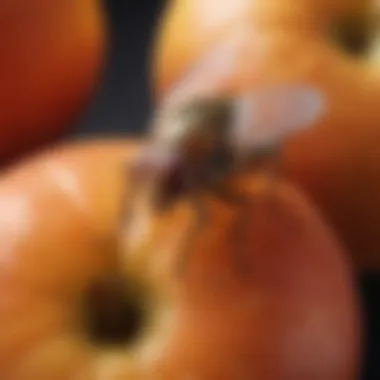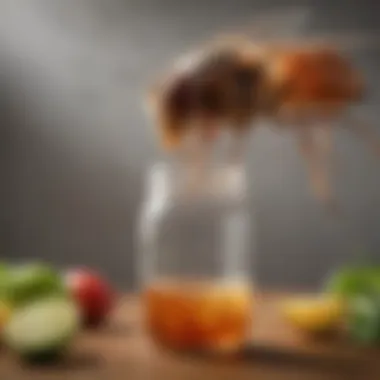Effective Strategies for Eliminating Fruit Flies


Intro
Fruit flies are a common nuisance in many households. They are particularly attracted to overripe fruit and other organic matter. Understanding their behavior and biology is crucial for effectively managing and preventing infestations. This article focuses on practical strategies that can be employed to eliminate fruit flies. From identifying attractants that invite them into your home to effective trapping techniques and natural remedies, the information presented will allow readers to maintain a clean and fly-free environment.
In the following sections, we will explore various approaches to combat fruit flies. Meddling with their environment not only impacts their presence but also creates a healthier living space. Let’s delve into these methods that can lead to a substantial reduction in the population of these pests.
Understanding Fruit Flies
Understanding fruit flies is essential in developing effective strategies for their elimination. Fruit flies, given their small size and rapid reproduction rates, can quickly escalate from a minor nuisance to a significant infestation. This article will examine their biology, behavior, and commonly recognized species, all of which are pivotal in tackling fruit fly problems effectively. By comprehending these factors, one can not only devise effective solutions but also implement preventive measures to maintain a fly-free environment.
Biology of Fruit Flies
Life Cycle
The life cycle of fruit flies is a critical aspect. It consists of four distinct stages: egg, larva, pupa, and adult. The entire cycle can be completed in about a week under ideal conditions. This rapid reproduction is a key characteristic, enabling fruit flies to proliferate quickly, which underscores the urgency of addressing potential infestations as soon as they are detected. The unique feature of their life cycle includes their ability to lay hundreds of eggs at once, which can lead to overwhelming populations if left unchecked. Understanding this cycle empowers individuals to take decisive action at various life stages, whether through targeted traps or thorough cleaning strategies.
Behavior Patterns
Behavior patterns of fruit flies contribute significantly to their presence in homes. They are attracted to fermenting fruits and vegetables, which serve as both food sources and egg-laying sites. This attraction is a vital characteristic for targeting eradication efforts. A unique aspect of their behavior includes their tendency to swarm around these food sources, which can provide clues to their infestation spots. Recognizing these patterns can help in devising effective strategies to eliminate their habitat, thereby reducing their numbers in your living space.
Common Species
Identification of Species
Identification of species is crucial for addressing fruit fly problems effectively. The most common species found in homes is the Drosophila melanogaster, commonly known as the vinegar fly. Its small size and distinctive red eyes make it easier to identify. However, other species like the Drosophila simulans may look similar, creating confusion. Recognizing which species you are dealing with can inform your eradication strategies, as different species may respond differently to traps and deterrents. This highlights the importance of correctly identifying the species to tailor the management approach appropriately.
Distribution
Distribution of fruit flies further emphasizes why understanding their habitat is important. Fruit flies thrive in environments with abundant food supplies, primarily in urban settings. Their almost worldwide distribution means that people across various regions face potential infestations. The fact that they are often found in and around garbage cans, compost heaps, and kitchens stresses the need for diligence in food storage and waste management practices. Knowing where these pests are typically found allows for targeted preventative measures to mitigate their presence before they become a larger issue.
Identifying Attractants
Understanding what attracts fruit flies is essential for their management. Identifying attractants can help in reducing their presence in homes. Fruit flies are drawn to specific substances, especially organic materials. Knowledge about these attractants enables individuals to take targeted actions, minimizing the likelihood of infestations. Moreover, recognizing these factors will facilitate more effective cleanup and prevention strategies, ultimately contributing to a more pleasant living environment.
Common Food Sources
Fruits
Fruits serve as a primary food source for fruit flies. The sweetness and fermenting qualities of many fruits make them particularly attractive. Bananas and apples are common examples. These fruits produce ethylene gas when ripening, which can further attract fruit flies.
The presence of overripe or decaying fruits significantly increases the likelihood of attracting these pests. It is beneficial to regularly inspect and remove any spoiled fruits, thus reducing the chances of infestation.
Vegetables
Vegetables can also attract fruit flies, though they might not be as prominent as fruits. Certain starchy vegetables, like potatoes and tomatoes, may draw fruit flies as they decompose. The rotting process releases odors that appeal to fruit flies.
Proper storage practices and timely consumption of vegetables can help minimize the risk. Keeping vegetables clean and ventilated helps deter pests.
Environmental Factors
Moisture Levels
Moisture levels are a critical factor in the attraction of fruit flies. Wet or damp areas promote breeding conditions. Common sources include spilled liquids or improperly stored food.


Controlling moisture by promptly cleaning spills and ensuring proper drainage can hinder fruit fly activity. This approach limits the opportunity for flies to thrive in environments with high humidity.
Temperature Conditions
Temperature conditions significantly influence fruit fly behavior. Warmer temperatures typically accelerate their life cycle, making infestations more likely. A suitable indoor temperature around 75°F can encourage fruit fly breeding.
Keeping living areas cool and well-ventilated can reduce their chances of establishing. Cold temperatures can slow down their activity, making it harder for them to breed.
Preventive Measures
Preventive measures play a crucial role in managing fruit fly populations effectively. The idea is to stay one step ahead, mitigating the conditions that attract fruit flies to your home. Implementing proper preventive measures not only aids in minimizing infestations but also ensures an overall cleaner and healthier living space.
Maintaining Cleanliness
Keeping your environment clean is essential for deterring fruit flies. This involves both food storage practices and regular cleaning routines.
Food Storage Practices
Food storage is a significant aspect of maintaining cleanliness. Properly storing food helps minimize the chances of attracting flies. The key characteristic of effective food storage is sealing all food items in airtight containers. This choice is beneficial because it removes access points for flies. It also preserves the freshness of your food.
Regular Cleaning Routines
Regular cleaning routines reinforce the effectiveness of food storage practices. A clean kitchen reduces the possibility of food residues that can attract fruit flies. The key characteristic of these routines is consistency. Sticking to a schedule for cleaning surfaces, including counters and floors, promotes a fly-free environment.
One unique feature of regular cleaning is its preventative nature. By routinely sanitizing areas where food is prepared and consumed, you actively reduce the chance of an infestation occurring. This method is advantageous, as it not only helps control fruit flies but also improves overall home cleanliness. A downside might be that maintaining a schedule requires dedication and effort.
Sealing Entry Points
Sealing entry points is equally crucial in the fight against fruit flies. This includes ensuring that windows and cracks are sealed to block potential access points.
Window Screens
Window screens are a practical component in minimizing entry points for fruit flies. The essential aspect of window screens is their ability to allow fresh air while preventing flies from entering. The effectiveness of screens can greatly reduce the likelihood of infestations.
A unique feature of window screens is their physical barrier that offers both visibility and protection. However, damaged or improperly fitted screens can render them ineffective. Regular maintenance of screens is necessary to keep them functional.
Cracks and Crevices
Addressing cracks and crevices around your home is another important aspect of sealing entry points. These small openings can serve as gateways for fruit flies to invade your space. The key characteristic of this strategy is that it targets access points that might be overlooked during routine cleaning.
A unique feature of repairing cracks is that it can greatly enhance your home's energy efficiency as well. One advantage of sealing these spaces is that it improves overall cleanliness. However, the downside can be the time and effort required to find and repair all fractures.
In summary, both maintaining cleanliness and sealing entry points form the backbone of preventive measures. Consistent effort in these areas is vital for effectively managing the presence of fruit flies in your environment.
Eradication Techniques
Eradication techniques are fundamental when it comes to effectively managing fruit fly infestations. Understanding these methods can lead to quicker and more efficient solutions to eliminate these pests. A good strategy encompasses both the use of homemade traps and commercial solutions. Each technique offers unique advantages and responds to different levels of infestation. The right choice can provide long-lasting control, which is essential for maintaining a fly-free environment.
Homemade Traps
Vinegar and Dish Soap
The mixture of vinegar and dish soap is often regarded as one of the simplest yet effective homemade traps for fruit flies. The key characteristic of this trap lies in its ingredients. Apple cider vinegar is particularly attractive to fruit flies due to its sweet scent. When mixed with a few drops of dish soap, it breaks the surface tension of the vinegar. This unique feature makes it difficult for the flies to escape once they land on the surface.
This trap is a beneficial choice for several reasons. First, it uses readily available materials, making it accessible to most households. Second, it is non-toxic, which is vital when considering safety around food and pets. However, it is worth noting that while this method can capture a considerable number of fruit flies, it might not be effective for larger infestations. Regular refreshing of the trap is necessary to maintain its efficacy.


Wine or Beer Trap
Another effective homemade solution is the wine or beer trap. The essence of using fermented beverages lies in their aroma, which draws fruit flies in. The key characteristic of this trap is its ability to utilize leftover wine or beer—making it a clever way to repurpose waste. This method works by enticing fruit flies with the scent of fermentation and trapping them in a container.
One unique feature of the wine or beer trap is its simplicity to create. You only need a container and the beverage of choice. Despite its accessibility, there are advantages and disadvantages. On the plus side, this type of trap is quite effective and often results in a high capture rate. However, it may be less appealing to those who prefer not to waste alcohol. Furthermore, similar to the vinegar trap, it requires regular maintenance to keep it effective.
Commercial Solutions
Food-Safe Sprays
Food-safe sprays are a crucial commercial solution designed specifically for tackling fruit fly problems. The main advantage of these sprays is their ease of use and targeting capability. They are formulated to eliminate fruit flies while being safe for use around food and in kitchens. This quality makes food-safe sprays an attractive option for many homeowners and food enthusiasts.
One key characteristic is that food-safe sprays often utilize natural ingredients, which minimizes health risks. Their effectiveness lies in the active ingredients that can swiftly eliminate flies on contact. However, users should be careful to follow instructions carefully, as improper use may lead to ineffective results. The disadvantage might be their temporary solution, meaning they may need to be reapplied regularly for continuous protection.
Electric Traps
Electric traps represent a more advanced method to combat fruit flies effectively. The unique aspect of these traps is their ability to use light and electric grids to attract and eliminate flying insects. This method ensures a systematic and ongoing capture of fruit flies, making it practical for more serious infestations.
A beneficial characteristic of electric traps is their efficiency. They often cover a larger area than homemade traps and can kill dozens of insects within a short time. However, this advantage comes with a caveat; electric traps require power sources, which may limit placement options in some homes. They can be more expensive than alternative methods but are considered a worthwhile investment for those frequently battling fruit fly infestations.
Effective eradication is key to maintaining a safe and enjoyable kitchen space. Whether you choose homemade traps or commercial solutions, understanding each method's strengths and weaknesses will empower you to combat fruit flies effectively.
Natural Remedies
Natural remedies are essential in the combat against fruit flies. These approaches often provide effective solutions without the need for harsh chemicals. They tend to be safer for both people and pets, thus making them a popular choice. By leveraging the power of nature, individuals can create environments that deter these pests while maintaining home safety.
Essential Oils
Essential oils have wide applications in pest control. Their strong scents can disrupt the olfactory senses of fruit flies, making it difficult for them to locate food sources. This characteristic makes essential oils a vital component when discussing natural remedies.
Uses of Lavender Oil
Lavender oil is known for its calming properties, but it also serves as a natural repellent against fruit flies. The distinctive scent primarily repels insects. Its significance lies in the ability to use it while enhancing the atmosphere of a home. One can mix lavender oil with water in a spray bottle and apply it around fruit bowls or kitchen counters.
A unique feature of lavender oil is its versatility. Not only does it deter fruit flies, but it also promotes a pleasant aroma. However, it is important to note that while effective, it may not completely eliminate fruit fly presence. Regular applications might be necessary to maintain its effectiveness.
Peppermint Oil Applications
Peppermint oil also plays a significant role in repelling fruit flies. Its strong, fresh scent is often associated with cleanliness, which helps to mask any food odors that may attract flies. The invigorating smell serves as a fantastic deterrent.
The unique aspect of peppermint oil is its refreshing and crisp aroma. Many people find it pleasant, making it a favorable option for home use. Like lavender oil, it is usually applied in a diluted mixture with water. However, some may find its scent overwhelming if used in excess. As such, careful measurement is vital when using this remedy.
Herbal Deterrents
Herbal deterrents offer another layer of protection against pests. They provide a natural alternative to synthetic solutions, enhancing home ambiance while keeping fruit flies at bay. These herbs can be placed in strategic locations around the house to maximize their effectiveness.
Using Basil
Basil is not only a culinary favorite but also an effective natural deterrent. Its strong aroma can significantly disrupt the attraction of fruit flies to food sources. By placing fresh basil leaves in areas where fruit flies are common, individuals may notice a decrease in their presence.
The significant characteristic of basil is its dual purpose. It can be used in various dishes while also serving as a pest repellent. One disadvantage is that basil needs to be replaced regularly to maintain freshness and effectiveness.
Mint as a Barrier
Mint serves as a formidable barrier against fruit flies. The intense scent emanating from mint leaves can deter flies from invading spaces where it is located. Placing pots of mint around kitchens or dining areas is a common practice that highlights its benefits.


A key strength of mint is its growth potential in gardens or window boxes. Not only does it keep pests at bay, but it can also be used in cooking or cocktails. Nonetheless, mint can spread quickly in gardens, which could be a disadvantage for some.
By integrating these natural strategies, you can create an environment that discourages fruit fly infestations effectively. Employing essential oils and herbs not only aids in pest control but can also enhance your living space.
Long-Term Solutions
Long-term solutions are crucial in maintaining an environment that is inhospitable for fruit flies. Unlike temporary fixes, which may provide instant relief, these methods ensure that infestations are less likely to recur. Implementing long-term strategies fosters a proactive approach to pest control that centers on prevention, rather than reaction.
By understanding the habits and breeding patterns of fruit flies, individuals can transform their spaces into fly-free zones. Positive outcomes of these strategies include reduced need for chemical treatments, improved hygiene, and a more pleasant living atmosphere.
Routine Maintenance
Regular Inspections
Regular inspections significantly contribute to effective fruit fly management. These inspections aim to identify potential breeding grounds and attractants early. A key characteristic of regular inspections is that they are often simple to conduct. They require no specialized training or equipment, making them accessible for anyone. During these inspections, you can keep track of fruits and vegetables stored in kitchens. Look particularly at any overripe or damaged produce, as these are key attractants for fruit flies.
The unique feature of regular inspections is that they help in catching pest issues before they escalate. By identifying small problems, you can address them quickly, which prevents the necessity for more extreme elimination methods later. This approach is not only preventive but also cost-effective in the long run.
Seasonal Cleaning Tips
Seasonal cleaning tips are essential to sustaining a fly-free environment. This aspect of maintenance encourages individuals to set specific times throughout the year to conduct thorough cleanings. A highly beneficial trait of seasonal cleaning is that it allows for deep cleaning processes that may be overlooked during regular cleaning routines. This includes checking behind appliances, clearing pantry spaces, and sanitizing waste areas.
The unique feature of seasonal cleaning is its comprehensive nature. It addresses areas where fruit flies might thrive, removing both food sources and potential breeding sites. However, this cleaning can appear overwhelming to some. It is advisable to break these tasks into manageable sections. This simply ensures that no significant areas are missed during cleaning.
Behavioral Adjustments
Responsible Food Disposal
Responsible food disposal is a fundamental behavior adjustment for preventing fruit flies. By understanding that discarded food can attract these pests, individuals can change how they manage waste. A primary characteristic of responsible food disposal is that it emphasizes the importance of rinsing food containers and sealing trash tightly. This approach keeps odors contained, which diminishes attraction for fruit flies.
Unique to this adjustment, responsible food disposal means reconsidering how to handle food leftovers. Rather than letting them sit out for extended periods, placing them promptly in the fridge or sealing them can greatly reduce fruit fly activity. The main downside here is that it requires mindfulness and changing daily habits. However, this shift can lead to a significant decrease in fruit fly populations.
Mindful Grocery Shopping
Mindful grocery shopping plays a pivotal role in long-term fruit fly prevention. By being conscious of the food you bring into your home, you can make informed choices that minimize fruit fly attractants. A key characteristic of this practice is that it encourages buyers to purchase ripe fruits and vegetables only when they are ready to use them.
The unique feature of mindful grocery shopping is its preventive nature. It pushes individuals to assess their consumption patterns before purchase, which can reduce overbuying. While this approach requires some planning and awareness, the advantage lies in keeping fresh produce manageable and minimizing waste. Making thoughtful choices in this area reflects broader attitudes toward sustainability and efficient living.
Implementing long-term solutions not only helps in dealing with fruit flies but also fosters an overall cleaner and healthier environment for all.
End
The conclusion of this article addresses how vital it is to have a systematic approach for managing fruit fly infestations. The strategies discussed are not just temporary solutions, but can also serve to prevent future outbreaks. Understanding fruit flies' biology and habits provides insight into their behavior. This knowledge empowers individuals to act effectively.
Recap of Strategies
In this article, various methods for eliminating fruit flies have been discussed. Important techniques include:
- Preventive Measures: Keeping the kitchen clean and sealing entry points reduces the chances of fruit flies entering your space.
- Eradication Techniques: Utilizing homemade traps, like vinegar and dish soap mixtures, alongside commercial options ensures more thorough control.
- Natural Remedies: Employing essential oils or herbal deterrents can provide a more eco-friendly solution.
- Long-Term Solutions: Establishing routine maintenance and changing behaviors around food waste can maintain a fruit fly-free environment.
A combination of these strategies creates a multi-faceted approach that can be adapted according to personal circumstances.
Encouragement for Ongoing Management
Staying vigilant in managing the presence of fruit flies is crucial. After implementing the strategies outlined, it is essential to continuously monitor your kitchen and surrounding areas. Simple actions, such as regularly inspecting for weaknesses or potential breeding sites, can prevent new infestations. Additionally, adopting mindful food shopping techniques—selecting fresher produce and using it quickly—greatly diminishes attraction.
Developing a habit of cleanliness will make it easier to maintain these changes.
Maintaining diligence in management serves as the best preventive measure against fruit fly infestations.
To ensure ongoing effectiveness, inform family members or roommates about the strategies in place. Engaging others in this effort reinforces shared responsibility and commitment to a fruit fly-free space. Overall, a constant effort towards proper food handling, disposal, and awareness will be your most powerful tools in keeping fruit flies at bay.







